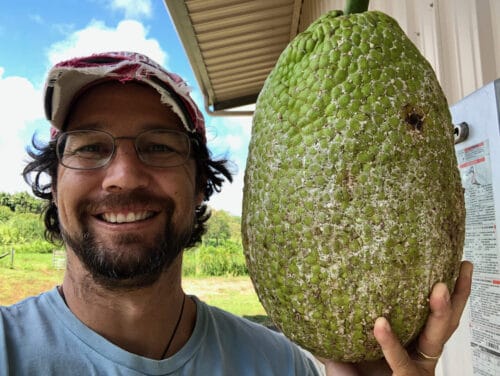Organisation
Mala Kaluulu Cooperative
What inspired your love for breadfruit?
While I have always known and eaten breadfruit, I would say my love for ‘ulu really grew during my time as an ethnobotanical educator about 15 years ago. After having traveled and studied around the world I had just come home to Hawai’i. It was a time when I began to merge my past experiences rooted in culture and those rooted in academia, and began to weave those two things together more as I educated youth (well…and adults). As I developed curriculum and thought about what we needed to teach young people, much of it was about how we interact with and care for our ‘aina – our land. Agriculture, as a fundamental interface between people and the environment, became a larger part of my focus. As I taught more about food and food systems I became increasingly aware of how amazing ‘ulu is!
After having traveled and studied around the world I had just come home to Hawai’i. It was a time when I began to merge my past experiences rooted in culture and those rooted in academia, and began to weave those two things together more as I educated youth (well…and adults). As I developed curriculum and thought about what we needed to teach young people, much of it was about how we interact with and care for our ‘aina – our land. Agriculture, as a fundamental interface between people and the environment, became a larger part of my focus. As I taught more about food and food systems I became increasingly aware of how amazing ‘ulu is!
What is one thing you would like people to know about breadfruit?
The one thing people need to know about breadfruit is everything. There are so many problems with our contemporary food systems. Issues of environmental impacts and degradation, of human health and nutrition, of cultural and aesthetic values, of ecosystem services and global climate change. What is most amazing about breadfruit is how many of these problems it can address simultaneously. As a long lived tree it immediately reduces environmental impacts compared to annual crops, storing more carbon and enhancing soil health. As a fruit it is relatively high in vitamins and minerals compared to many other carbohydrate sources. As a tree it can host more biodiversity and can be grown in diversified systems of production. And on and on.
How have you been working or affiliated with the crop?
There are three main hats I wear in working with ‘ulu. The first has been as a researcher, starting with my PhD research over 10 years ago and now continuing on a range of breadfruit growing and production research. My lab conducts interdisciplinary research into indigenous crops and cropping systems, including ethnography and ethnohistory, biogeochemistry, social and political ecology, and agronomy. The second has been as a farmer, and my wife and I initiated a breadfruit agroforestry system in south Kona at our farm, Māla Kalu’ulu Cooperative. The farm is used to for research, education, and production on breadfruit. Finally, I am a member and serve as the production advisor for the Hawai’i ‘Ulu Producers Cooperative, which is the largest producer network and processor of breadfruit in Hawai’i. Here I work closely with the management team to work on production and processing issues that arise for their supply chain.
What is your favorite breadfruit dish?
I don’t know that it is my favorite, but one that I do a lot is twice cooked patties. Lightly steam ‘ulu, then mash by hand with garlic, onion, Worcestershire sauce, salt, pepper and egg and form into patties. Then pan sear on medium-high heat.
In your opinion do you think breadfruit is a worthy opponent in the battle to conquer world hunger?
Absolutely.
Do you have a favorite breadfruit story?
Yes, but it’s personal 🙂
What is one important message you would like people to know or learn about breadfruit?
If you plant a tree in your backyard you can feed a family of four. Do it.
